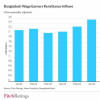Evaluating highest credit ratings during uncertainties

Credit ratings highlight a borrower's creditworthiness, wherein a higher rating refers to the superior credit quality of an individual or entity and the notion that it deserves greater investor confidence.
Despite heightened macroeconomic volatilities, some listed financial firms in Bangladesh have recently received the highest AAA credit rating. In contrast, many advanced economies, including the US, still maintain AA or AAA credit ratings, depending on the rater. Therefore, on a relative scale, can we assert that these firms have similar or even better creditworthiness than the sovereigns with the strongest economies in the world?
While some might argue that there is no clear-cut answer to the question, it may be worthwhile for investors and policymakers to be cautious in any attempts to rely (or over-rely) on such rating assessments, especially as risks continue to rise.
Several plausible reasons support this careful approach.
Over the years, a large body of academic work has highlighted how overstated credit ratings can mislead investors and encourage them to commit more funds than is desirable.
For instance, the global financial crisis of 2008 is often considered a significant event that shows how the credit ratings of complex financial products were consistently misjudged, and in the post-crisis phase, resulting in increased risks for the general investors. Eventually, to safeguard these investments and curb the financial instability, significant government intervention in the form of an extensive bail-out occurred, prompting considerable increases in government spending.
First, for the investors, the experience from the global financial crisis provides vital lessons. The main takeaway would be to make more prudent financial investment choices.
To further elaborate, a AAA credit rating can suggest that an entity has the lowest possible default probabilities and would be easily able to meet all the financial obligations. This inference can trigger a large inflow of funds (or deposits in the case of banks) or even raise the demand for an entity's stocks, increasing their prices. Thus, such increases in market activities backed by excellent credit ratings may make it harder for investors to easily detect firm-specific risks or anomalies that can initiate in unpredictable market conditions.
Suppose the firm-specific fundamentals do not remain significantly strong to justify the highest possible rating. In that case, a credit rating downgrade can quickly decline the value of the capital providers' investments. Therefore, in addition to making their own financial evaluations, it may be necessary for investors or savers to consider several credit rating assessments suggested by multiple credit rating agencies, local and international.
After reviewing these ratings, the investors can make informed decisions about putting additional funds into such entities.
Second, as for the policymakers, the global financial crisis is also relevant in providing robust evidence as to how the decline in investor confidence can trigger a need for bail-outs and result in considerable changes to the pre-existing fiscal policies. These problems can exacerbate further if there are disruptions to the financial system.
More specifically, our domestic economy is predominantly a bank-based financial system where most business funding is sourced from commercial banks rather than capital markets. Therefore, along with the overall economic development, it is natural for banks to grow in size (by assets) and sometimes become too big to fail.
Primarily, for these financial institutions, an exogenous shock due to a downgrade in credit ratings can raise the total risks and lead to difficulties in debt servicing. In extreme circumstances, government support may be needed to protect the depositors and avoid macroeconomic instability, which can raise total government spending.
Thus, while it is essential for both investors and policymakers to not over-depend on any credit rating, taking into account the rating reviews done by multiple rating agencies for an entity may be more valuable.
In effect, one can find large deviations between the ratings of different raters for the same entity, making it harder to evaluate the precise credit rating. However, revisions to such ratings or the rating outlook can be more insightful in such cases.
For instance, if an entity receives a rating upgrade from most of the major rating agencies, one can be more optimistic and confident about the positive changes in the economic health of that entity.
Taken together, it may undoubtedly seem surprising to see many entities being upgraded to the highest possible rating when macroeconomic risks are rising in our domestic environment. Such high ratings during economic uncertainties also highlight the importance for the investors to carefully vet any such ratings, consider multiple rating assessments, and conduct their own evaluations of investment choices.
Based on the experience around the world, policymakers and regulators may also need to be wary of the economic implications of the inaccurate perceptions about credit ratings that the general investors may have.
Nonetheless, suppose there is some coherence between the upgrades (or revisions) made in ratings by multiple agencies for any given entity. In that case, there is some consensus on the improvement (or changes) in the entity's financial position. Such consistent inferences can then enable more optimal decision-making for the investors.
The author is a lecturer at North South University.

 For all latest news, follow The Daily Star's Google News channel.
For all latest news, follow The Daily Star's Google News channel. 





Comments